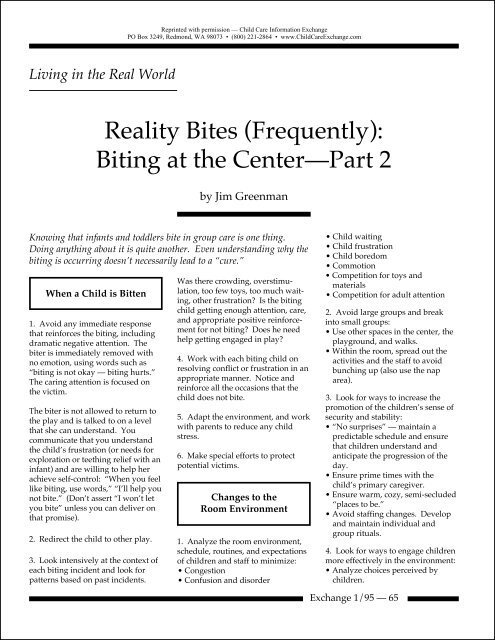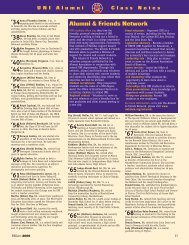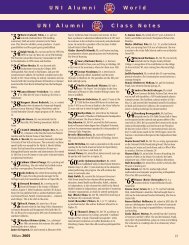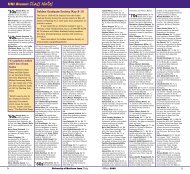Reality Bites (Frequently): Biting at the CenterâPart 2
Reality Bites (Frequently): Biting at the CenterâPart 2
Reality Bites (Frequently): Biting at the CenterâPart 2
You also want an ePaper? Increase the reach of your titles
YUMPU automatically turns print PDFs into web optimized ePapers that Google loves.
Living in <strong>the</strong> Real World<br />
<strong>Reality</strong> <strong>Bites</strong> (<strong>Frequently</strong>):<br />
<strong>Biting</strong> <strong>at</strong> <strong>the</strong> Center—Part 2<br />
by Jim Greenman<br />
Knowing th<strong>at</strong> infants and toddlers bite in group care is one thing.<br />
Doing anything about it is quite ano<strong>the</strong>r. Even understanding why <strong>the</strong><br />
biting is occurring doesn’t necessarily lead to a “cure.”<br />
When a Child is Bitten<br />
1. Avoid any immedi<strong>at</strong>e response<br />
th<strong>at</strong> reinforces <strong>the</strong> biting, including<br />
dram<strong>at</strong>ic neg<strong>at</strong>ive <strong>at</strong>tention. The<br />
biter is immedi<strong>at</strong>ely removed with<br />
no emotion, using words such as<br />
“biting is not okay — biting hurts.”<br />
The caring <strong>at</strong>tention is focused on<br />
<strong>the</strong> victim.<br />
The biter is not allowed to return to<br />
<strong>the</strong> play and is talked to on a level<br />
th<strong>at</strong> she can understand. You<br />
communic<strong>at</strong>e th<strong>at</strong> you understand<br />
<strong>the</strong> child’s frustr<strong>at</strong>ion (or needs for<br />
explor<strong>at</strong>ion or teething relief with an<br />
infant) and are willing to help her<br />
achieve self-control: “When you feel<br />
like biting, use words,” “I’ll help you<br />
not bite.” (Don’t assert “I won’t let<br />
you bite” unless you can deliver on<br />
th<strong>at</strong> promise).<br />
2. Redirect <strong>the</strong> child to o<strong>the</strong>r play.<br />
3. Look intensively <strong>at</strong> <strong>the</strong> context of<br />
each biting incident and look for<br />
p<strong>at</strong>terns based on past incidents.<br />
Was <strong>the</strong>re crowding, overstimul<strong>at</strong>ion,<br />
too few toys, too much waiting,<br />
o<strong>the</strong>r frustr<strong>at</strong>ion Is <strong>the</strong> biting<br />
child getting enough <strong>at</strong>tention, care,<br />
and appropri<strong>at</strong>e positive reinforcement<br />
for not biting Does he need<br />
help getting engaged in play<br />
4. Work with each biting child on<br />
resolving conflict or frustr<strong>at</strong>ion in an<br />
appropri<strong>at</strong>e manner. Notice and<br />
reinforce all <strong>the</strong> occasions th<strong>at</strong> <strong>the</strong><br />
child does not bite.<br />
5. Adapt <strong>the</strong> environment, and work<br />
with parents to reduce any child<br />
stress.<br />
6. Make special efforts to protect<br />
potential victims.<br />
Changes to <strong>the</strong><br />
Room Environment<br />
1. Analyze <strong>the</strong> room environment,<br />
schedule, routines, and expect<strong>at</strong>ions<br />
of children and staff to minimize:<br />
• Congestion<br />
• Confusion and disorder<br />
• Child waiting<br />
• Child frustr<strong>at</strong>ion<br />
• Child boredom<br />
• Commotion<br />
• Competition for toys and<br />
m<strong>at</strong>erials<br />
• Competition for adult <strong>at</strong>tention<br />
2. Avoid large groups and break<br />
into small groups:<br />
• Use o<strong>the</strong>r spaces in <strong>the</strong> center, <strong>the</strong><br />
playground, and walks.<br />
• Within <strong>the</strong> room, spread out <strong>the</strong><br />
activities and <strong>the</strong> staff to avoid<br />
bunching up (also use <strong>the</strong> nap<br />
area).<br />
3. Look for ways to increase <strong>the</strong><br />
promotion of <strong>the</strong> children’s sense of<br />
security and stability:<br />
• “No surprises” — maintain a<br />
predictable schedule and ensure<br />
th<strong>at</strong> children understand and<br />
anticip<strong>at</strong>e <strong>the</strong> progression of <strong>the</strong><br />
day.<br />
• Ensure prime times with <strong>the</strong><br />
child’s primary caregiver.<br />
• Ensure warm, cozy, semi-secluded<br />
“places to be.”<br />
• Avoid staffing changes. Develop<br />
and maintain individual and<br />
group rituals.<br />
4. Look for ways to engage children<br />
more effectively in <strong>the</strong> environment:<br />
• Analyze choices perceived by<br />
children.<br />
Exchange 1/95 — 65
• Analyze <strong>the</strong> developmental<br />
appropri<strong>at</strong>eness of choices.<br />
• Provide duplic<strong>at</strong>ions and multiple<br />
options.<br />
• Consider whe<strong>the</strong>r to increase <strong>the</strong><br />
motor and sensory choices available.<br />
5. Look for ways to calm children<br />
after periods of excitement:<br />
• Relaxed transactions<br />
• Calming music<br />
• Calming physical contact with<br />
caregivers<br />
6. Analyze grouping of children to<br />
avoid combin<strong>at</strong>ions th<strong>at</strong> might lead<br />
to conflict or biting:<br />
• Avoid grouping biters and likely<br />
“victims” toge<strong>the</strong>r.<br />
• Avoid grouping children who will<br />
compete for toys.<br />
Epidemic Response<br />
When biting changes from a rel<strong>at</strong>ively<br />
unusual occurrence of a<br />
couple times a week to a frequent<br />
and expected occurrence, it should<br />
be considered an epidemic or health<br />
emergency, a serious thre<strong>at</strong> to <strong>the</strong><br />
well being of <strong>the</strong> children in <strong>the</strong><br />
room (including <strong>the</strong> biter). Wh<strong>at</strong><br />
happens in health emergencies We<br />
apply extraordinary resources to <strong>the</strong><br />
crisis.<br />
Do <strong>the</strong> following:<br />
1. Room staff meet with <strong>the</strong> director<br />
and/or assistant director on a daily<br />
basis throughout <strong>the</strong> crisis for<br />
advice, support, and to maintain a<br />
perspective devoid of blame (children,<br />
parents, or staff).<br />
2. Chart every occurrence, including<br />
<strong>at</strong>tempted bites, and indic<strong>at</strong>e loc<strong>at</strong>ion,<br />
time, participants, behaviors,<br />
staff present, and circumstances.<br />
3. Evalu<strong>at</strong>e <strong>the</strong> immedi<strong>at</strong>e staff<br />
response to each biting situ<strong>at</strong>ion to<br />
ensure appropri<strong>at</strong>e intervention th<strong>at</strong><br />
includes:<br />
• Comforting <strong>the</strong> injured child and<br />
tre<strong>at</strong>ing <strong>the</strong> injury.<br />
• Cool, firm, disapproving response<br />
to <strong>the</strong> biter th<strong>at</strong> does not inadvertently<br />
provide reinforcement to <strong>the</strong><br />
biter.<br />
4. Analyze <strong>the</strong> chart and profile <strong>the</strong><br />
behavior p<strong>at</strong>terns and <strong>the</strong> environmental<br />
context of frequent biters and<br />
frequent victims.<br />
5. “Shadow” children who indic<strong>at</strong>e a<br />
tendency to bite and:<br />
• Anticip<strong>at</strong>e biting situ<strong>at</strong>ions.<br />
• Teach non-biting responses to<br />
situ<strong>at</strong>ions and reinforce appropri<strong>at</strong>e<br />
behavior in potential biting<br />
situ<strong>at</strong>ions.<br />
• Adapt <strong>the</strong> program to better fit <strong>the</strong><br />
individual child’s needs.<br />
6. “Shadow” children who have a<br />
tendency to be bitten:<br />
• Anticip<strong>at</strong>e biting situ<strong>at</strong>ions.<br />
• Teach responses to potential biting<br />
situ<strong>at</strong>ions th<strong>at</strong> minimize <strong>the</strong><br />
chance of becoming a victim.<br />
7. Consider early transition of<br />
children “stuck” in a biting behavior<br />
p<strong>at</strong>tern for a change of environment,<br />
if developmentally appropri<strong>at</strong>e (and<br />
allowed by licensing).<br />
8. If necessary, bring in outside<br />
observers to help you analyze <strong>the</strong><br />
entire situ<strong>at</strong>ion (not just <strong>the</strong> biter).<br />
Maintain Positive<br />
Rel<strong>at</strong>ionships with Parents<br />
1. Let all <strong>the</strong> parents know th<strong>at</strong> <strong>the</strong>re<br />
is a problem and everything th<strong>at</strong> you<br />
are doing to stay on top of it.<br />
2. Remind <strong>the</strong>m of your philosophy<br />
regarding working with children in<br />
crisis — like a child stuck in a biting<br />
mode.<br />
3. Work toge<strong>the</strong>r as partners with<br />
<strong>the</strong> parents of both biting children<br />
and frequent “victims” to keep <strong>the</strong>m<br />
informed and develop a joint str<strong>at</strong>egy<br />
for change.<br />
4. Prepare <strong>the</strong> parents of <strong>the</strong> biting<br />
child for <strong>the</strong> worst if suspension or<br />
termin<strong>at</strong>ion from <strong>the</strong> program is<br />
possible and suggest <strong>the</strong>y make<br />
contingency plans. Having to leave<br />
<strong>the</strong> program is a terrible consequence,<br />
having to leave with little<br />
warning is even worse.<br />
“I Dreaded Going to<br />
Work”<br />
The head teacher in a<br />
room undergoing a rash of<br />
biting described wh<strong>at</strong> it<br />
was like:<br />
You don’t know how lousy it<br />
feels when biting gets out of<br />
control. Four bites today,<br />
three bites yesterday, six<br />
bites last Friday. I went<br />
through periods of feeling<br />
like a terrible teacher.<br />
I didn’t want to face <strong>the</strong><br />
o<strong>the</strong>r parents. I’d get angry<br />
<strong>at</strong> <strong>the</strong> biting kids and see Ben<br />
and Becca as if <strong>the</strong>y were<br />
<strong>the</strong>se little monsters and<br />
want to kick <strong>the</strong>m out. And I<br />
felt even more angry with<br />
<strong>the</strong>ir parents! I wanted <strong>the</strong>m<br />
to do more, take more<br />
responsibility, be more<br />
structured, more loving,<br />
more something.<br />
All of <strong>the</strong>se feelings swirled<br />
around, although only my<br />
husband had to hear <strong>the</strong><br />
wails and moans. I knew <strong>the</strong><br />
feelings weren’t fair and it<br />
took all my professionalism<br />
to stuff <strong>the</strong>m down.<br />
Exchange 1/95 — 66
Hanging On<br />
There are no magic fe<strong>at</strong>hers to<br />
“solve” a biting crisis. Sometimes<br />
nothing works and children grow<br />
out of it or leave <strong>the</strong> program. Doing<br />
all of <strong>the</strong> above should help allevi<strong>at</strong>e<br />
or shorten <strong>the</strong> crisis.<br />
Maintaining good rel<strong>at</strong>ionships with<br />
parents during a biting epidemic<br />
requires all <strong>the</strong> trust and good<br />
will built up by good program<br />
practice.<br />
Because it is a “n<strong>at</strong>ural” and inevitable<br />
occurrence — like illness,<br />
earthquakes, and floods — all we<br />
can do is prepare for biting and<br />
maintain perspective while it is<br />
happening. It is <strong>the</strong> time when our<br />
expertise, professionalism, and<br />
character are put to <strong>the</strong> test.<br />
Jim Greenman is vice president of<br />
Resources for Child Care Management<br />
and author of Caring Spaces,<br />
Learning Places: Children’s<br />
Environments Th<strong>at</strong> Work<br />
(Exchange Press).<br />
Exchange 1/95 — 67






